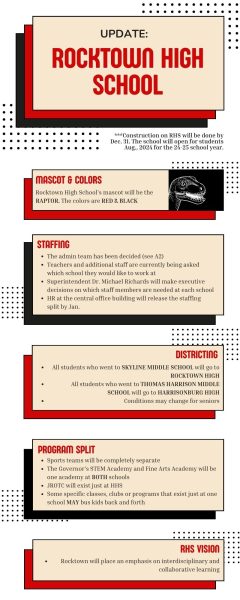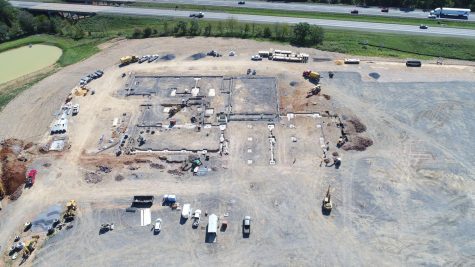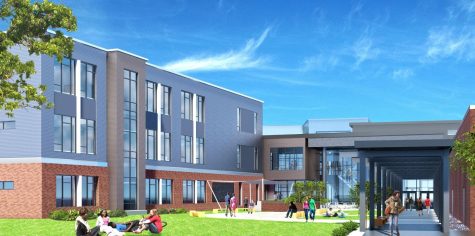Richards proposes phased approach to building of new school
Harrisonburg City Public Schools’s newest high school is slated to open in the fall of 2022, but it is now a possibility that the entire school will not be built by then. Superintendent Michael G. Richards and two other school board members devised an alternative plan for building the new high school that would delay construction of sports facilities until the school building is completed.
“Some city council members and the city manager expressed to me and board members that they’re uncomfortable with the tax rate going up and the debt capacity going down,” Richards said. “[The phased approach] would save a little bit on taxes and make quite an impact on the debt capacity, and [it] would save the city an extra seven million dollars over [a] five year period.”
The original plan was to build the complex all at one time and have all of the facilities open fall of 2022, with two separate schools and two student populations. However, with a phased approach, the main school building would be operational in 2022, while other facilities such as an auxiliary gym, tennis courts and a four million dollar stadium would be completed by 2025. This plan would have every high school student in the division be under the same mascot for the first five years, then break off into two separate high schools.
“If the city council funds the original proposal, then the school board will make a boundary decision [sooner],” [It’s] very important for people to understand [that] with the phased in plan, for five years everyone will still be a Blue Streak.”
The plan would theoretically decrease the tax burden, and the amount the city would borrow for the building would be reduced by 7.7 million according to Richards.
“High schools are very expensive to build no matter how you slice it, [but the approach] would reduce the tax burden about $10 a year per taxpayer,” Richards said. “You would still need a tax increase, [but] with the phased in approach the big difference is in the debt capacity. The city has to borrow [much] less so that’s the biggest impact.”
However, with the phased approach to building the school, there is a risk that the facilities will cost more to build due to costs and labor.
“There are going to be more costs down the road,” Richards said. “There’s risk that rates will go up, and there’s a pretty calculated risk that materials will cost more. [We would be taking] a bit of a chance with the phased in [approach].”
Richards believes that the controversy surrounding the new school is a result of people not understanding the extent of the overcrowding problem and not wanting to pay any more in taxes.
“Other people need to understand that when they pay for the younger generation, that contributes to everybody. [The students] are the future and the future for the city,” Richards said. “Even though [some] don’t have children, even if they don’t spend any time in any of the schools; it’s everybody’s school. It’s being argued that way like ‘why do I have to pay for this, it’s their school.’”
Richards believes that community and student involvement throughout the planning process is crucial to the school’s eventual success.
“I’ve been to community meetings to talk about [the school]; I go to neighborhoods and advocacy groups,” Richards said. “I appreciate naysayers, [because it] is democracy. You have diversity and [diverse] viewpoints and I make my case that this is for everybody and it makes the city stronger.”
As for the school, the plot of land has been acquired, located between Interstate 81 and South Main Street. Richards believes that it will be a suitable place for the school, especially once additional sound barriers are created.
“It is a really beautiful piece of land once you’re on it. I take board members up to it and you don’t really notice the highway except for the distant noise of cars. It’s sheltered a bit more from 81 than people realize and that’s just with the natural trees. The architects have designed a way to push the earth in that direction so that there’s more of a barrier,” Richards said. “When you look out [from] it, you see the beautiful landscape. When you’re out there you feel like you’re out in the country for some reason; it’s a very expansive piece of land and its beautiful.
Richards acknowledges that the location wasn’t ideal, especially for the first few years of the schools being connected if the phased approach is implemented. However, the two locations are just over three miles from each other.
“It’s not as bad as people think. I understand the confusion of why that piece of land, and of course I wasn’t part of that decision,” Richards said. “I think it’s a good spot. I cant put words in peoples mouths from three [or] four years ago; I can’t pretend to understand what they were thinking. They may have been thinking that if it worked for JMU it may work for us.”
The design for the school has a maximum capacity of 1,257 students, slightly less than the 1350 students that HHS was designed for.
“[HHS] is designed for 1350 students for programing, which means we don’t want more than 1350 students to be in classrooms at one time. We have trailers because we have so many more than that,” Richards said. “The one that’s being designed’s [maximum capacity is] 1257, so it’s a bit smaller.”
The design is shaped with a large middle part surrounded by wings for different academic departments.
“What’s interesting is with the design, you can build onto the wings. It’s shaped with a big middle part with these wings, and you can build onto the wings so you can add up to 1500 [students],” Richards said. “[The design is innovative because] as we grow as a city we have room to build on.”
Richards believes that student opinions on the new school will aid in the final details and appreciates the ideas that spawned from student groups such as the Superintendent’s Advisory Committee.
“This is where [the students] are going to live 8 hours a day, and this is going to be a huge part of developing their future. The students are at the center,” Richards said.
In the meantime, Richards believes that it is necessary to address the overcrowding issues now as the school population approaches 2,000 students. He does not support the trailers as a multi-year remedy as they present problems for students and faculty.
“I don’t like [trailers] because it’s not ideal for students or teachers. It’s supposed to be a temporary remedy, and it’s usually used as an interim plan for a reason. I don’t want students walking in the rain to get to class; [I] don’t want students separated from their peers for long periods of time, and I don’t want teachers do deal with that either,” Richards said. “I don’t like it. The overcrowding is intolerable, and the trailers are not the way to [fix the problem]. [They’re] a band aid, and its time to rip off the band aid.”








